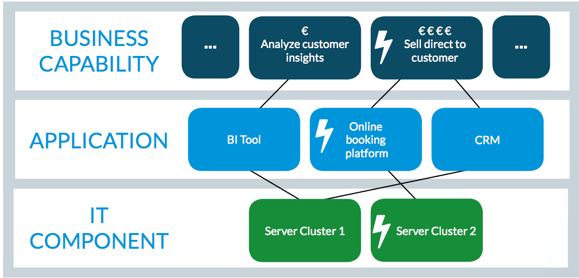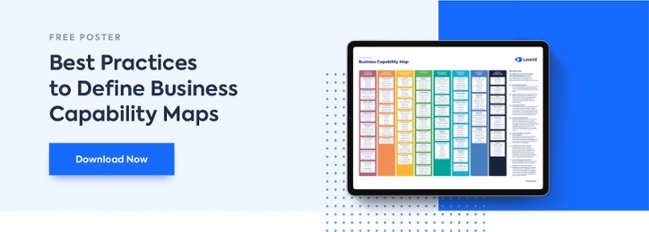 In the second blog of our series "Business Capabilities: How to win the digital age with a common language for Business & IT", we will explain why business capabilities make life easier.
In the second blog of our series "Business Capabilities: How to win the digital age with a common language for Business & IT", we will explain why business capabilities make life easier.
“Business capabilities help to identify redundancies in IT, to spot risks and to develop innovative technology solutions ”
 The ultimate goal of a business capability-driven IT strategy is to deliver tangible results. Let us look at three examples:
The ultimate goal of a business capability-driven IT strategy is to deliver tangible results. Let us look at three examples:
Merger Management
Imagine that a multinational insurance company has recently acquired a local insurance player and a massive project team has been set up to integrate both companies. One of the big challenges they face is integrating and consolidating applications. The team has to decide which applications can be used in the future and which ones will be phased out. What makes the task a difficult one is that organizational structure and processes differ strongly between the two companies.
Rather than getting lost in the details of processes or the uncertainties of organizational charts, a target business capability model helps to structure the whole merger. By mapping the applications of both organizations to the new capability model it can be decided which applications are kept and which are discontinued.
But this application of business capabilities is not restricted to merger activities. Very often in large companies with multiple business units and legal organizations the starting situation is not much different from a merger. Business capabilities can serve as the structuring element to uncover redundancies in IT. McKinsey estimates the saving potential to be 15 - 20%. In many industries the cost of IT can make up 5% or more. This means that for a company with €1 billion revenue, there is an opportunity to save €5 million year in, year out. A business capability model helps to discuss the areas of strategic invest or divest.
IT risk management
Recently, the awareness of technology risks has seen an increase, be it due to new external regulations or security breaches. CIOs see themselves faced with questions like the following: Do my applications meet the regulatory standards? Which applications support critical business activities? What does it mean if a certain application fails? A study by KPMG has shown that attention to technology risks pays of. The consultants estimate that each IT incident (outage) costs on average €590,000.
Balancing the need to reduce these risks and maintaining or even decreasing costs longs for an integrated approach. By linking business capabilities to applications that again are linked to technology components, a strategic risk assessment can be conducted. With the right information in place a CIO can deliver a statement such as: “We cannot accept the risk of an end-of-live server cluster because it provides the infrastructure for our online booking system that is crucial to our capability to sell direct to customers. Selling direct to customers has highest strategic priority due to its financial impact.”

Innovation Management
The use of business capabilities should not stay restricted to a pure bottom-line focus. They are also a great help in structuring thoughts on how to transform business and IT. In the digital age companies need to investigate capability by capability and think about how they can transform them. A trade fair organizer could look at its “Manage Pricing” capability. In the past it might have followed a simple per square meter pricing. In the future, IT could enable a pricing based on auctioning of leads.
We will come back to some of these examples in the last section and make some suggestion on how to do this in practice.
Three main characteristics of Business Capabilities
In a nutshell business capabilities are well suited for these kind of exercises due to three main characteristics:
- Firstly, they are the most stable reference for planning in organizations. As the basic capabilities a business needs to achieve its goals only change in times of major transformations (e.g. shift in business model or merger) they are well suited for executing the IT strategy. Strategy statements are often abstract. Processes tend to get very detailed and projects are quickly moving.
- Secondly, business capabilities make the strategy much more tangible. They resonate well with executives and at the same time are easily understood by employees in IT. “Pricing & Yield Management”, “Booking platform management” and “Promotions & Loyalty Management” are a much more concrete than the strategy statement of a hotel chain CEO to “Better utilize existing capacities”.
- And lastly, business capabilities - if properly defined - can help to overcome organizational silos. Especially in larger companies, the same capability might be needed in multiple places in the company. While it can make perfect sense that three business units all do their own recruitment, it could pay off to think about the best possible technology support rather from a capability (Recruit great employees) than from an organizational (find employees for business unit A) perspective.
So, did the subject catch your attention and you now are interested in more? We have the perfect (free) little tool for you! Your own best practice business capability maps!
![Realizing Post-Merger Synergies in Your IT Application Landscape [White Paper]: Find out what methods for consolidating IT Application Landscapes exist and what steps should be taken to consolidate an IT landscape from a merger. »](https://no-cache.hubspot.com/cta/default/2570476/0f519a27-d637-4199-8f21-d82b80d9fbed.png)




